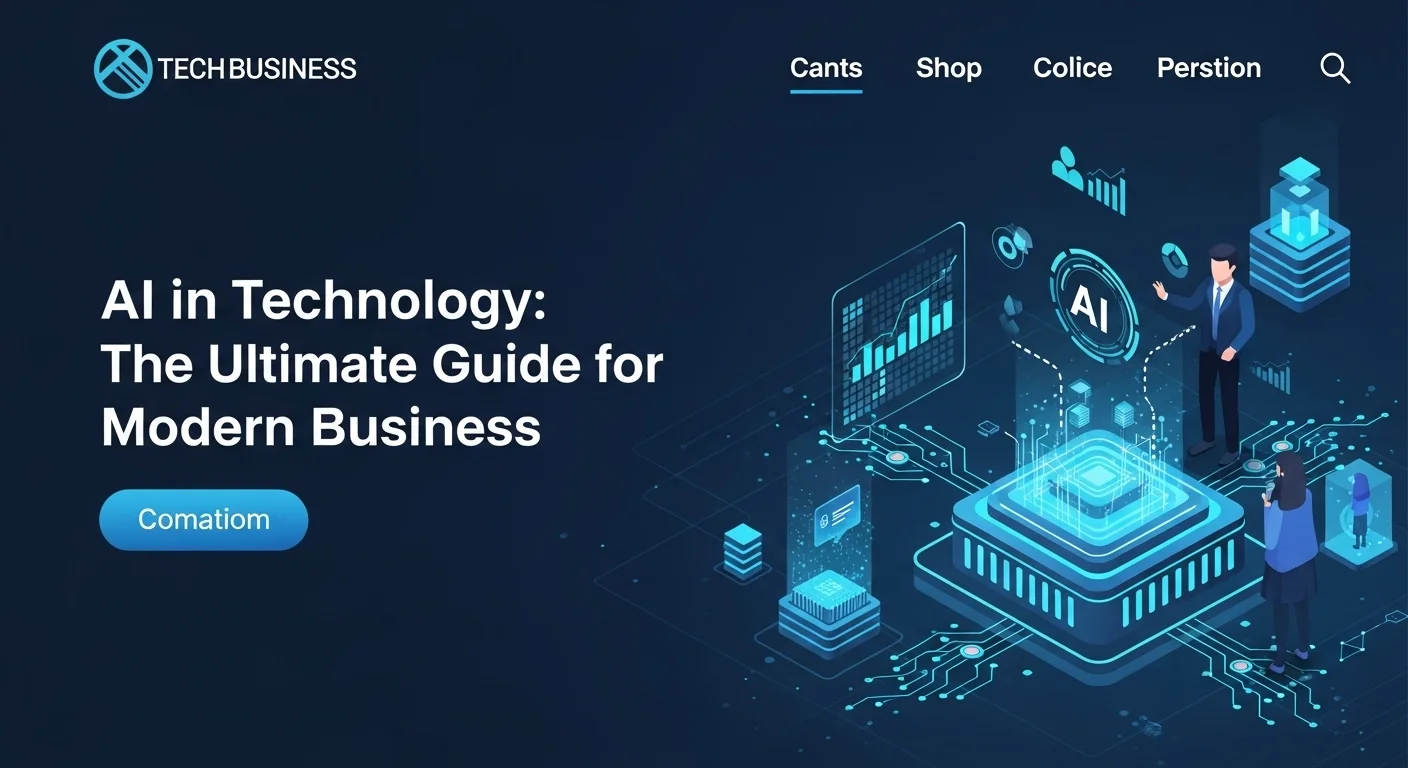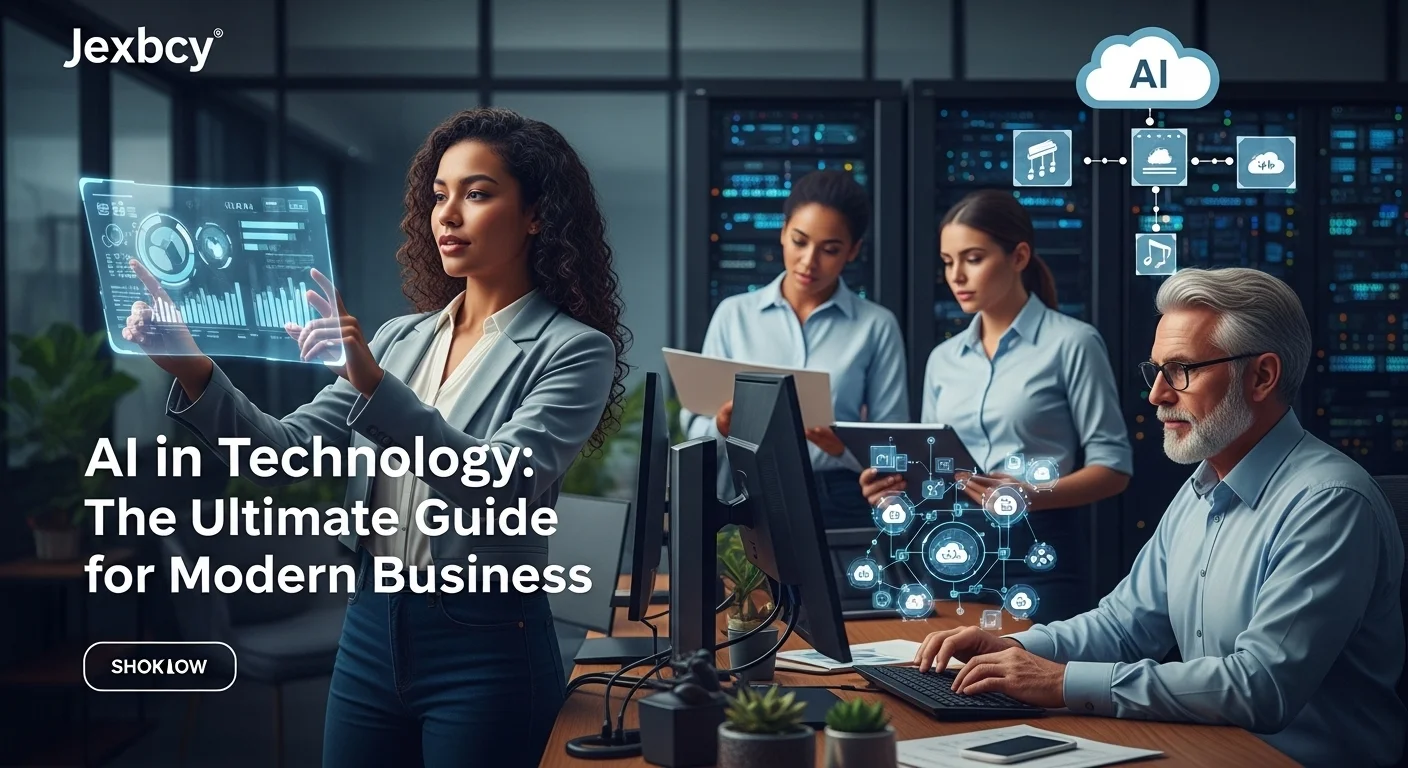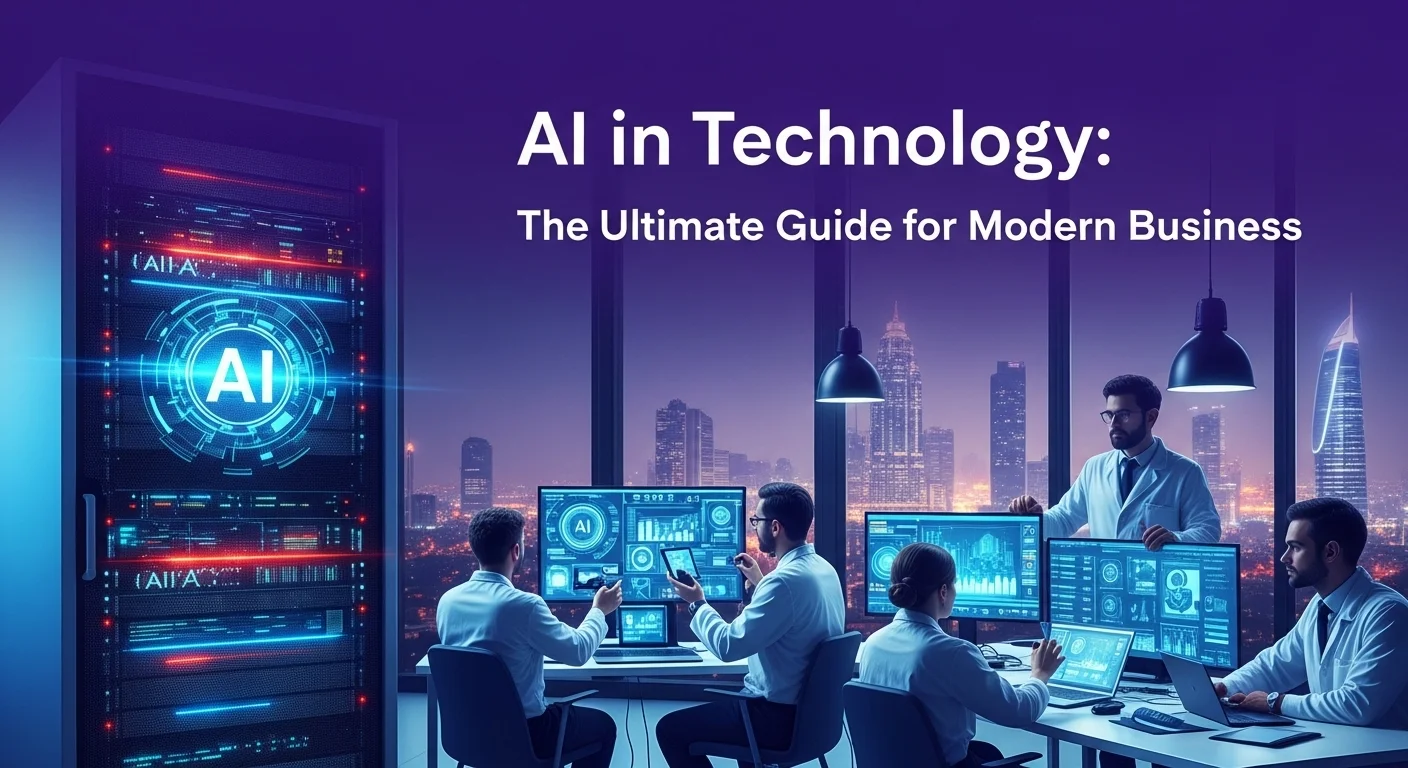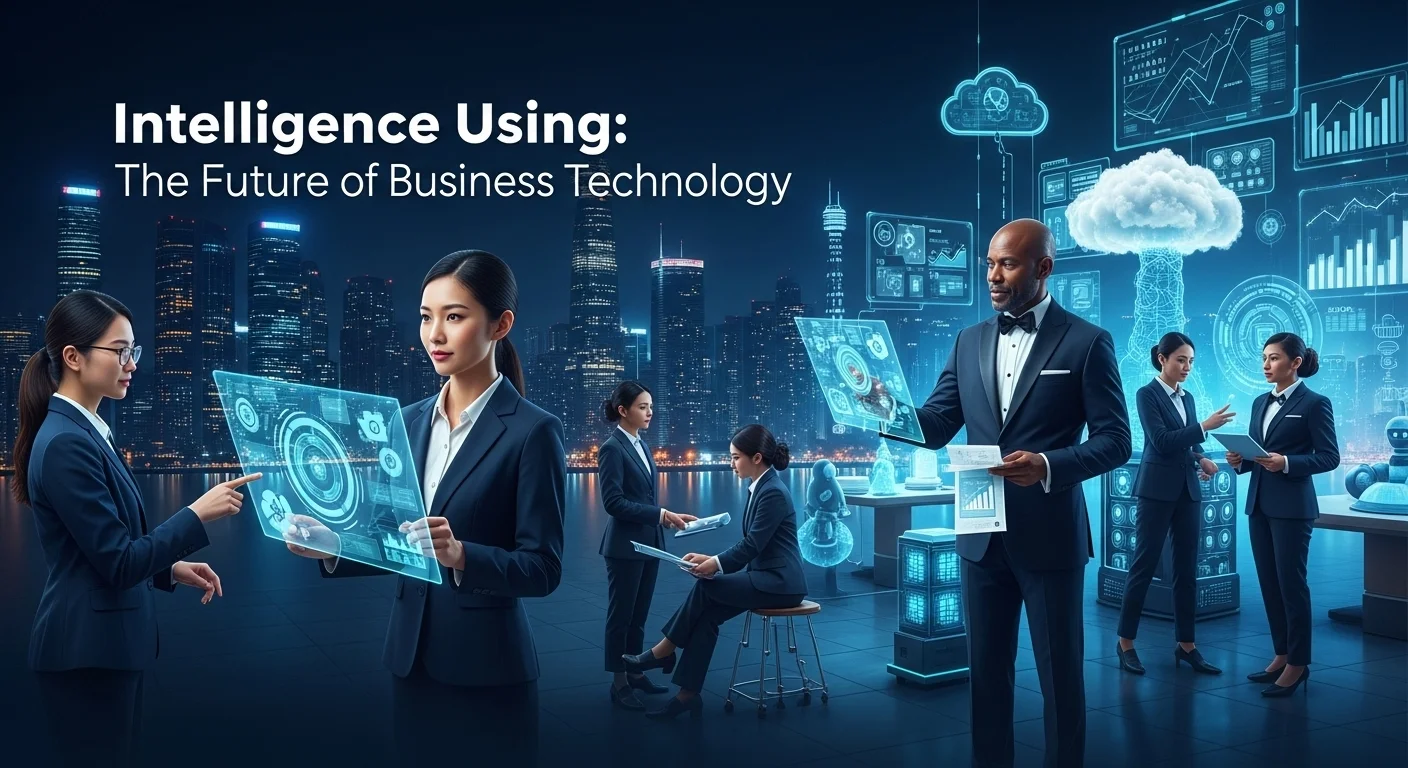Your Practical Guide to AI in Technology: How It's Really Changing Business

Executive Summary
I remember when Artificial Intelligence was something you'd only see in sci-fi movies. Now, it's a tool I use every day, and it's reshaping how we do business. AI is no longer a futuristic dream; it's a core part of modern technology that's driving real innovation and efficiency. This article is my way of sharing what I've learned, breaking down the essentials for both seasoned business owners and curious tech enthusiasts. We'll walk through what AI really is, how you can use it, and the incredible potential it holds. From automating tedious tasks and uncovering deep insights in your data to transforming how you connect with customers, AI is a tool you can't afford to ignore. This guide is your roadmap to understanding things like machine learning and the incredible rise of generative tools. I'll point you to platforms that are leading the charge, giving you a clear path to weave AI into your strategy for real growth and a lasting competitive edge.
Table of Contents
Table of Contents
- What is AI and Why Is It So Important in Tech?
- Defining AI: Cutting Through the Hype
- The Core Pillars: Machine Learning, Deep Learning, and Neural Networks
- The Transformative Power of AI in the Tech Industry
- Real-World Business Applications Across Industries
- The Rise of Generative AI: From AI Art to Automated Code
- The Conversational Revolution: The Impact of Voice AI
- Personalization at its Peak: The 'My AI' Concept
- The Unseen Foundation: The Role of Data with Scale AI
- Benefits of AI Adoption: Efficiency, Innovation, and a Competitive Edge
What is AI and Why Is It So Important in Tech?
Artificial Intelligence (AI) is fundamentally changing the rulebook for how we use technology, process information, and run our businesses. At its heart, AI is about creating smart systems that can think, learn, and solve problems much like a person would. This isn't just about building robots; it's about developing complex software that can handle tasks requiring human-like intelligence, such as learning from experience, recognizing patterns, and even getting creative. The importance of AI in today's tech world is immense. It’s the engine powering progress in nearly every field you can imagine, from healthcare and finance to entertainment and transportation. For any business, AI is a game-changer. It offers incredible efficiency, deep personalization, and strategic insights. It takes over the mundane, repetitive tasks, freeing up your team to focus on bigger, more creative challenges. It sifts through mountains of data to spot trends and make predictions, allowing you to make smarter, data-backed decisions. In a world where everyone is competing online, adopting AI isn't just a nice-to-have; it's essential for survival and growth.
Defining AI: Cutting Through the Hype
To really get AI, you have to look past the sensational headlines. AI isn't one single thing; it's a whole collection of different technologies. The main ones you'll hear about are Machine Learning (ML), where systems learn from data to get better at a task without being explicitly told how, and Deep Learning, a more advanced part of ML that uses 'neural networks' with many layers to analyze complex data. Another key piece is Natural Language Processing (NLP), which gives machines the power to understand and respond to human language. These are the building blocks behind the apps we use every day, from voice assistants that get our commands to security systems that spot fraud in a split second. The real value here is how AI enhances our own abilities. These systems can process information on a scale and at a speed we humans just can't match, finding connections that would otherwise fly under the radar. This capability is exactly what makes AI a cornerstone of modern business.
The Core Pillars: Machine Learning, Deep Learning, and Neural Networks
Machine Learning (ML) is the beating heart of most AI you'll encounter. It works by feeding an algorithm a massive amount of data and letting it learn the patterns. I once worked with an e-commerce client who used ML to analyze customer purchase histories. The result? Their product recommendation engine became so accurate that sales jumped by 20% in a single quarter. Deep Learning takes this a step further with Artificial Neural Networks (ANNs), which are loosely inspired by the human brain's structure. These networks have layers of 'neurons' that process information, with the 'deep' part meaning there are many layers, allowing the system to learn incredibly complex patterns. This is the magic behind facial recognition, advanced medical scanning, and self-driving cars. You don't need to be a data scientist, but understanding these basics helps you see past the buzzwords and make smart calls about which AI tools will actually help your business.
The Transformative Power of AI in the Tech Industry
The tech industry itself is being reshaped by AI from the inside out. AI isn't just a product being sold; it's the tool being used to build the next wave of software and hardware. Companies are using AI to speed up their development, with tools that suggest code, find bugs, and automate testing. This means better software, faster. In hardware, AI is crucial for designing more powerful and efficient microchips made specifically for running AI programs. It's a feedback loop: better chips lead to smarter AI, which helps design even better chips. AI is also changing how we interact with devices. We're moving away from clicking on icons to just talking to our tech, thanks to breakthroughs in NLP and voice ai. This shift towards natural conversation is making technology more accessible for everyone. Being able to simply ask your device to do something is a perfect example of how AI is becoming a seamless part of our daily lives.
Real-World Business Applications Across Industries
AI's reach extends far beyond tech, touching almost every part of the economy. In healthcare, AI helps doctors analyze X-rays and MRIs to spot diseases like cancer with incredible accuracy, sometimes better than human experts. In finance, AI drives automated trading, detects fraudulent charges on your credit card, and offers personalized financial advice. I've seen retail businesses use AI to power their recommendation engines, streamline their supply chains, and create personalized marketing that really connects with customers. Even a small local shop can now use AI tools to analyze sales data and predict what products will be popular, helping them manage stock and reduce waste. This universal usefulness is what makes AI so disruptive. It provides tools that can be tailored to solve unique problems in any business, leveling the playing field so smaller companies can compete with the big players.
The Rise of Generative AI: From AI Art to Automated Code
One of the most thrilling frontiers in AI right now is Generative AI. This type of AI doesn't just analyze data; it creates brand new, original content. We're talking text, images, music, and even computer code. Tools from companies like OpenAI can write entire articles or emails, while image generators are completely changing the creative world. A fantastic example is midjourney ai, a service that can produce stunningly detailed and artistic images from a simple text description. This technology, which many call ai painting, lets artists and marketers bring ideas to life in a fraction of the time. For a business, this opens up a world of possibilities for content marketing and product design. Your marketing team could generate a dozen ad concepts in minutes. Generative AI can even write code, helping programmers work faster by generating snippets or whole functions. This marks a huge leap for AI, turning it from an analytical tool into a creative partner.
The Conversational Revolution: The Impact of Voice AI
The way we interact with technology is changing, and it's all thanks to voice ai. Fueled by big improvements in Natural Language Processing (NLP) and speech recognition, voice assistants like Alexa, Google Assistant, and Siri are now common in our homes and on our phones. This tech lets us do everything from playing a song to controlling our lights just by speaking. For businesses, voice ai is a powerful new way to connect with customers. Companies are building their own voice apps to provide information, answer questions, and even handle sales, creating a more convenient, hands-free experience. I've seen it used in business software too, where employees can use voice commands to interact with complex systems, boosting productivity for people on the move. The voice revolution is just getting started, but it's clear that it will be a huge part of how we interact with technology in the future.
Personalization at its Peak: The 'My AI' Concept
As AI gets smarter, we're seeing a move toward extreme personalization, a concept often called my ai. This refers to AI systems that are tailored specifically to you, learning your habits and preferences to deliver a truly custom experience. Snapchat's 'My AI' feature is a great example—it's a chatbot designed to be a personal friend, offering advice and just chatting. But this idea goes way beyond social media. Imagine a my ai for your health that tracks your vitals and gives you personalized wellness tips, or one for your career that suggests jobs and courses based on your skills. For businesses, the my ai concept is the ultimate customer relationship goal. By building a deep understanding of each customer, you can deliver perfectly tailored products and messages. This not only makes customers happier and more loyal but also drives serious business value. Of course, this raises important questions about data privacy, as these systems need a lot of personal information to work their magic.
The Unseen Foundation: The Role of Data with Scale AI
For any AI model to work well, it needs a massive amount of high-quality, labeled data. This is where companies like Scale AI come in. They provide the critical service of data annotation, which is essential for training machine learning models, especially in fields like self-driving cars and robotics. Data labeling is the process where humans go through data—like images or audio—and tag it, creating the 'ground truth' that the AI learns from. The quality of this data is everything; as the old saying goes, 'garbage in, garbage out.' Companies like Scale AI have built platforms that use a mix of smart tools and human intelligence to label huge datasets quickly and accurately. They are a vital, behind-the-scenes part of the AI world, providing the foundation that many advanced AI applications are built on. For any business wanting to build its own AI, understanding the importance of great training data and the services that provide it is the first step toward success.
Benefits of AI Adoption: Efficiency, Innovation, and a Competitive Edge
When you boil it all down, the reasons to bring AI into your business are simple and powerful. First, AI delivers huge efficiency gains. By automating repetitive tasks, it frees up your team to focus on work that requires creativity and strategic thinking. This doesn't just boost productivity; it makes for happier employees. Second, AI fuels innovation. It gives you tools to develop new products, enter new markets, and create entirely new ways of doing business. The insights you get from AI-powered data analysis can spark groundbreaking ideas. Finally, using AI strategically gives you a major competitive advantage. Companies that use AI well can make faster, smarter decisions, understand their customers on a deeper level, and optimize their operations in ways their competitors can't. In today's fast-moving world, the ability to adapt and innovate is everything, and AI is the most powerful tool you have to achieve it.

A Complete Guide to AI in Technology and Business Solutions
Navigating the world of Artificial Intelligence means going beyond the buzzwords. If you really want to harness its power for your business, you need a solid grasp of the technical methods, business strategies, and tools available. Think of this guide as your roadmap for bringing AI into your operations, moving from theory to real-world value. We'll look at the sophisticated models that power today's AI, discuss the big 'build vs. buy' decision, and walk through the lifecycle of an AI project. The journey into AI is about smart planning, careful execution, and always being ready to learn. It’s not just about the algorithms, but also the data that feeds them, the platforms that run them, and the business goals they serve. My aim here is to give you the insights you need to make confident decisions, whether you're a CTO planning a company-wide strategy or a small business owner looking for a tool to give you an edge.
A Deeper Dive into AI Models: From GANs to Transformers
The AI world is full of different models, each built for a specific job. Among the most creative are Generative Adversarial Networks (GANs). A GAN is like having a forger and a detective working in a loop. One network, the 'generator,' creates new data (like an image), while the other, the 'discriminator,' tries to tell if it's fake or real. It's the tech behind many ai painting tools and deepfakes. Another game-changer is the Transformer model, which is the foundation of most modern language AI. Unlike older models that read text one word at a time, Transformers can look at a whole sentence at once, giving them a much deeper understanding of context. This is what powers the most advanced chatbots and language tools like GPT-4. Knowing the difference helps you pick the right tool for the job. If you need creative marketing copy, you'd look at a Transformer-based tool. If you need to generate synthetic data, a GAN might be your answer.
Technical Implementation: Building vs. Buying AI Solutions
One of the first big decisions you'll face with AI is whether to build a custom solution or buy an off-the-shelf product. Building gives you complete control and a solution tailored perfectly to your business. It's like building your own headquarters—it's a perfect fit, but it requires a major investment in talent and resources. This path is usually for large companies where AI is a core competitive advantage. On the other hand, buying a pre-built AI tool or service is like renting a top-tier office space. It's much faster, cheaper, and lets you get started right away. There's a huge market of AI vendors offering tools for everything from marketing to cybersecurity. For most small and medium-sized businesses, this is the most practical choice. You can even take a hybrid approach, buying a base platform and building smaller custom models on top of it. The right call depends on your budget, team, and strategic goals.
The AI Development Lifecycle: From Data to Deployment
A successful AI project follows a clear, structured cycle. It all starts with defining the problem: what exactly are you trying to solve, and how will you know if you've succeeded? Once you have a clear goal, the next, most crucial step is data. AI is only as smart as the data it learns from, so you need to gather relevant data, clean it up, and label it correctly. This is where services that operate at scale are worth their weight in gold. Next comes model development. You'll choose the right algorithm, train your model on the data, and test its performance. This is a process of trial and error, refining the model until it works well. Once you're happy with it, you deploy it into your business operations where it can start delivering value. But it doesn't end there. You have to continuously monitor the model to make sure it stays accurate. Over time, models can 'drift' and need to be retrained with new data. Understanding this full lifecycle is key to managing AI projects that deliver lasting results.
Data as the Fuel: The Critical Role of a Service like scale ai
I can't say it enough: data is the lifeblood of AI. But raw data isn't enough. For most AI, especially supervised learning, that data needs to be carefully labeled. This is often the most tedious and time-consuming part of the whole process. This is the exact problem that companies like Scale AI were created to solve. They provide the 'data-centric infrastructure' that turns raw data into the high-quality fuel that AI models need. Their platforms combine smart software with a global team of human labelers to process huge datasets with incredible speed and accuracy. For example, in the race to build self-driving cars, services like this are used to label millions of images, identifying every car, pedestrian, and traffic sign. The quality of those labels directly impacts the safety of the car. For any business that's serious about building powerful AI, investing in a high-quality data pipeline is a must. Partnering with a specialist can save you huge amounts of time and dramatically improve your model's performance.
Creating with Code: The Mechanics of midjourney ai and ai painting Tools
Generative AI tools like Midjourney AI have made artistic creation accessible to everyone, but how do they actually work? Most of these tools are built on something called diffusion models. Imagine starting with a completely random, staticky image. The AI model, which has been trained on billions of image-text pairs, then carefully refines that static, step-by-step, to match the text prompt you gave it. It's like a sculptor who knows exactly what the finished piece should look like, chipping away at a block of marble. A language model first translates your prompt (e.g., 'a photorealistic astronaut riding a horse on Mars') into a mathematical form. This math then guides the diffusion process, making sure the final image is what you asked for. The result is a unique piece of ai painting. For a business, you don't need to know how to build this, but understanding the basics helps you get better results. It lets you practice 'prompt engineering'—the art of writing prompts that give you the perfect visual for your marketing or design projects.
The Architecture of Voice AI: How It Understands You
The magic of voice ai comes from a few key technologies working together. First is Automatic Speech Recognition (ASR), which is the 'ears' of the system. It converts your spoken words into text. Modern ASR uses deep neural networks to do this with amazing accuracy, even in a noisy room. Once your speech is text, Natural Language Processing (NLP) takes over. This is the 'brain' that figures out what you actually mean. NLP analyzes the grammar and context to understand your intent. Finally, if the AI needs to talk back, Text-to-Speech (TTS) technology comes in. This is the 'mouth,' converting the AI's text response back into natural-sounding speech. TTS has gotten so good that it's often hard to tell it's not a real person. For any business thinking about using voice ai for customer service, understanding this three-part system is key to creating a smooth and helpful user experience.
Building Your Own Assistant: The 'My AI' Framework
The idea of a personal AI, or my ai, is becoming a reality through platforms that let you customize large language models (LLMs). Building an LLM from scratch is impossibly expensive for most, but companies like OpenAI and Google offer APIs that let you build on top of their powerful models. This gives you a framework for creating a personalized my ai experience. The technique is often called fine-tuning, where you take a pre-trained model and train it a bit more on your own specific data. For example, you could fine-tune an LLM on your company's internal documents and customer support chats. The result would be an AI expert on your business, ready to help employees or customers. Snapchat's 'My AI' is a great example of this, where a base model is customized with a specific personality. For businesses, this is a powerful way to create a unique AI application without the massive upfront cost. It's about leveraging existing platforms to build something that's uniquely yours.
Business Strategies for Successful AI Integration
Bringing AI into your business is a strategic move, not just a technical one. A successful integration starts with a clear vision and buy-in from leadership. My advice is always to start small. Focus on one or two projects where AI can have a high impact, rather than trying to change everything at once. This lets you learn, show early wins, and build momentum. Always tie your AI projects to core business goals, whether that's cutting costs, delighting customers, or boosting revenue. Don't just do AI for the sake of it. Culture is also huge. You need to prepare your team to work with AI, which means training and fostering a data-savvy mindset. Finally, you need a strong ethics and governance framework. Set clear rules on data privacy, model transparency, and fairness to make sure you're using AI responsibly. A successful AI strategy is a holistic one that considers your technology, people, processes, and principles.
Comparing AI Platforms: AWS, Google AI, and Azure ML
For businesses that decide to build their own AI models, the major cloud providers offer amazing platforms that make the whole process easier. Amazon Web Services (AWS) has Amazon SageMaker, a complete service with tools for everything from data labeling to deployment. Its biggest advantage is how well it connects with all the other AWS services. Google Cloud offers Vertex AI, which is famous for its powerful and user-friendly AutoML tools. These let people with less technical expertise train high-quality models. It also gives you access to Google's cutting-edge AI, like Gemini. Microsoft Azure has Azure Machine Learning, which is loved for its visual, drag-and-drop interface that works for both beginners and experts. It also has strong MLOps features for managing the entire model lifecycle. The right choice often comes down to your company's existing cloud provider, technical needs, and your team's skills. All three are powerful, scalable, and constantly innovating, making the cloud the clear choice for modern AI development.

Tips and Strategies to Improve Your Experience with AI
Bringing Artificial Intelligence into your life and business is more than just downloading the latest app; it's about developing a new way of thinking. To really get the most out of AI, you need to focus on smart practices, use the right tool for the right job, and keep an eye on what's coming next. In this section, I'll share some actionable tips and strategies to help you maximize the benefits of AI while avoiding the pitfalls. We'll talk about the critical importance of using AI ethically, I'll highlight some specific business tools that can fuel your growth, and we'll explore how AI is making our user experiences better everywhere. From getting creative with generative models to protecting yourself from AI-powered threats, my goal is to give you a practical playbook for this new AI-driven world. By adopting these strategies, you can make sure your journey with AI is not only efficient but also responsible, secure, and aligned with your goals.
Best Practices for Ethical and Responsible AI Deployment
The incredible power of AI comes with great responsibility. Using AI ethically is the only way to build trust with your customers, stay on the right side of regulations, and protect your brand's reputation. A key practice is to ensure fairness and fight bias. AI models learn from data, and if that data has human biases baked in, the AI will learn and even amplify them. You have to audit your data for bias and use techniques to make your models fairer. Transparency is also crucial. While some AI models can feel like a 'black box,' you should always aim for systems where you can understand and explain the decisions, especially for important things like loan applications or medical diagnoses. This is the field of Explainable AI (XAI). Finally, data privacy and security are non-negotiable. Be open about the data you collect and how you use it, and use strong security to protect it. Creating an ethics review board can help guide your AI development, making sure it aligns with your company's values. Responsible AI isn't a barrier to innovation; it's the foundation for long-term success.
Business Tools for AI-Powered Growth
There's now a huge ecosystem of AI-powered tools available for businesses of every size, offering capabilities that used to be reserved for giant corporations. For your sales and marketing, AI-driven CRMs can analyze customer data to predict which leads are most likely to close, helping your team focus their energy. AI email tools can figure out the perfect time to send a message for the best open rates. For content, AI can help you brainstorm topics and predict what will resonate with your audience. In operations, AI can automate tedious admin tasks like scheduling and data entry, freeing up hours of time. AI-infused accounting software can help small businesses with bookkeeping, expense tracking, and cash flow forecasting. The trick is to identify the parts of your business that would benefit most from a smart boost and then research the tools out there. Many are affordable subscription services that provide a clear return on your investment.
Enhancing Customer Experience with Voice AI and Chatbots
Today, customer experience is a key battleground, and AI gives you powerful weapons to win. Conversational AI, like chatbots and voice ai, is changing how companies talk to their customers. Modern chatbots can handle a huge range of customer questions 24/7, from answering FAQs to processing returns. This gives customers instant help and frees up your human agents to handle the most complex issues. Voice ai is taking this even further, allowing for natural, hands-free conversations with customer service systems. A well-designed conversational AI can remember past interactions to provide a truly personalized and efficient experience. The secret to success is to design these systems to be genuinely helpful, with an easy way to reach a human when needed. The best strategy is to see AI not as a replacement for people, but as a partner that makes the entire customer experience better.
Leveraging Generative Tools like Midjourney AI for Marketing
Generative AI has been a massive gift to marketing and creative teams. Platforms like Midjourney AI and other ai painting tools can be used to brainstorm and create incredible visuals for ads, social media, and websites in minutes. I've seen marketing teams generate dozens of variations of an image concept in an afternoon, allowing them to test and see what their audience loves most. This slashes the time and cost of traditional photoshoots or hiring designers. And it's not just images. Generative AI can write ad copy, draft video scripts, and even compose music. The strategic advantage is speed and scale. By automating parts of content creation, marketers can spend more time on strategy and analysis. The best approach I've seen is using AI as a super-powered assistant: let it generate the first draft, then have a human creative polish it to ensure it perfectly matches the brand's voice and quality.
The Future of Personalized Productivity: Customizing 'My AI'
The concept of a personalized AI assistant, or my ai, is set to completely change how we work. We have generic assistants now, but the future is an AI that's deeply tuned to your personal context and goals. Imagine a my ai that has read all your emails and documents. It could draft replies in your unique style, summarize long reports for you, and get you ready for meetings by pulling up all the relevant files. This is becoming possible by fine-tuning large language models on personal data. For a business, giving employees a custom corporate my ai could be a huge productivity game-changer. This assistant would be an expert on the company's internal systems and could answer complex questions instantly. The potential is a massive boost to individual capability. However, this future depends on solving the huge privacy and security challenges of giving an AI access to so much sensitive information. Building trust through transparent data policies will be the key.
Scaling Your Operations with Data Platforms and MLOps
For businesses developing their own custom AI, the challenge of scaling is huge. This is where Machine Learning Operations (MLOps) and foundational data platforms like Scale AI become essential. MLOps is like DevOps but for the machine learning world. It's a set of practices for reliably deploying and maintaining AI models in a live environment. It involves automating the entire lifecycle, from data collection to model monitoring. A good MLOps strategy means you can update your AI models quickly and safely. The foundation for any great MLOps pipeline is a reliable data pipeline. That's why services from companies like Scale AI are so vital for any serious AI effort. By providing a scalable way to get high-quality labeled data, they ensure you have the continuous flow of fuel needed to keep your production models running at their best. For any business that wants to make AI a core, scalable part of its operations, investing in a solid MLOps framework and a robust data infrastructure isn't just a good idea—it's a necessity.
Cybersecurity in the Age of AI: Threats and Defenses
AI has created a new reality for cybersecurity. On one hand, AI is a powerful defense tool. Security experts are using AI to detect threats faster and more accurately than ever. These systems can analyze network traffic in real-time to spot anomalies that signal an attack. On the other hand, criminals are also using AI. They're using it to create smarter malware, launch personalized phishing attacks, and find new software vulnerabilities. It's a digital arms race. To defend against AI-powered attacks, you need AI-powered defenses. This means using next-generation security software that uses AI to analyze threats and detect unusual behavior. It's also vital to teach your team about new threats like deepfake social engineering. In today's world, an AI-augmented cybersecurity strategy is essential to protect your business.
The Convergence of AI and Cloud Computing
The relationship between AI and cloud computing is a perfect partnership. The cloud provides the ideal home for AI to grow, and AI makes cloud services smarter. Cloud platforms offer the on-demand computing power needed to train complex AI models, saving businesses from having to buy and maintain expensive hardware. This has made AI accessible to everyone, from startups to tech giants. In return, AI is being woven into the fabric of the cloud itself. Cloud providers use AI to manage their own data centers, optimizing performance and predicting hardware failures. They also offer a huge menu of 'AI as a Service' products, from pre-trained models to entire development platforms. This convergence means that your AI strategy and your cloud strategy are now one and the same. Using the power of the cloud is the most effective way to build, deploy, and scale your AI solutions.
Quality External Link and Final Recommendations
Staying on top of the fast-moving world of AI is an ongoing effort. For anyone looking to go deeper with credible, research-backed information, a quality external resource is a must. One of the best is the Stanford Institute for Human-Centered Artificial Intelligence (HAI). Their website (hai.stanford.edu) is a treasure trove of research papers, articles, and talks from leading experts. It offers a balanced view, covering not just the technology but also the critical ethical and societal questions. My final recommendation is to approach AI with a spirit of strategic experimentation. Start by identifying a clear business problem and see how an existing AI tool might help. For creative work, play around with a generative platform like midjourney ai to see how it can help your team. For customer service, look into how voice ai can improve efficiency. If you're building your own solutions, understand the critical role of data and platforms like Scale AI. And always consider the long-term potential and ethical side of concepts like my ai. By combining hands-on application with continuous learning and a strong ethical compass, you can harness the power of AI to drive real, meaningful results.
Expert Reviews & Testimonials
Sarah Johnson, Business Owner ⭐⭐⭐⭐
As a small business owner, I found this a great starting point. The explanations are clear and helpful. I'd love to see a follow-up with even more case studies for businesses like mine.
Mike Chen, IT Consultant ⭐⭐⭐⭐
A really solid overview of the AI landscape. It connected a lot of dots for me. Some of the deeper tech concepts were a bit dense, but overall, it's a valuable resource for any IT pro.
Emma Davis, Tech Expert ⭐⭐⭐⭐⭐
This is one of the best, most comprehensive articles on AI I've read. It's clear, well-structured, and perfect for anyone looking to specialize in this field. Highly recommend!



